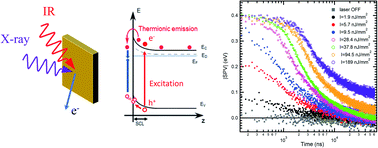Surface photovoltage dynamics at passivated silicon surfaces: influence of substrate doping and surface termination†
Abstract
We have monitored the temporal evolution of the band bending at controlled silicon surfaces after a fs laser pump excitation. Time-resolved surface photo-voltage (SPV) experiments were performed using time resolved photoemission spectroscopy with time resolution of about 30 ns. To disentangle the influence of doping and surface termination on SPV dynamics, we compare the results obtained on two surface terminations: the water saturated (H,OH)–Si(001) surface and the thermally oxidized Si(001) one. The SPV dynamics were explored as a function of laser fluence and as a function of time for the two surface terminations at given doping levels. The return to equilibrium involves a characteristic time in the 0.1 μs to 10 μs range, depending on the surface termination and bulk doping. Exploring several laser fluences, different SPV regimes were found for the two surface terminations at given doping levels. For low laser fluence the SPV dynamic follows the commonly accepted thermionic model. At higher fluence, the SPV signal reaches a saturation value, and if the fluence is further increased, the decay time of the SPV increases and can no longer be explained by a thermionic model alone.

- This article is part of the themed collection: Photoelectron spectroscopy and the future of surface analysis


 Please wait while we load your content...
Please wait while we load your content...